Lynskey Monster Cross Bike – The Third Revision
Since the creation of this rig in late 2013, its subtle evolution continues as improvements in drivetrain components become available. The drivetrain has always been centered around electronic shifting – I (JOM) am a firm believer in this technology. Having ridden and raced in some appalling conditions, Shimano’s Di2 systems have proven bombproof reliable – no cables or housings to foul, and no worries about cable tension. Just don’t forget to check your battery status before you head out for a ride or race!
Brakes, on the other hand, have been a source of contention. Disc brakes are fantastic in all sorts of weather, and I certainly appreciate the simplicity and ease associated with working on mechanical disc brakes. Unfortunately, in very trying (and muddy) conditions, infiltration of mud and schmutz into my brake cable housings and the bearings / brake actuator arms themselves has led to brake failure. Nothing can keep wet Georgia red clay at bay.
For the second revision of my Lynskey Monster CX bike, I took the plunge with Shimano’s hydraulic Di2 shifters and brakes. No regrets with that upgrade, brake performance is outstanding. For the third and latest revision, I have installed Shimano’s XTR Di2 derailleurs, which were very handy in solving another problem that cropped up when I converted to 11 speed on the Lynskey. More about that HERE.
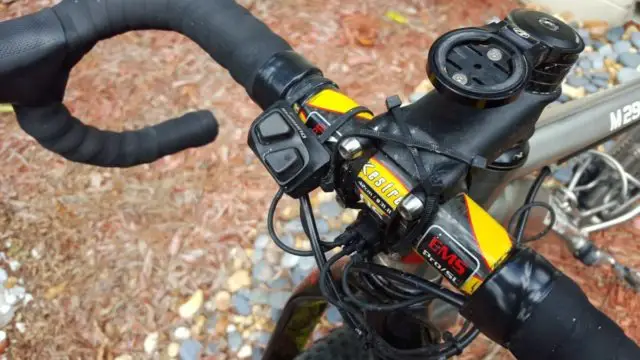
Without further ado, Revision three.
JOM’s Lynskey Monster Cross Bike – 3rd Time Lucky
Frame: Lynskey M290 29’er, Titanium 3/2.5 construction.
Fork: Niner RDO 29er, thru axle.
Headset: Cane Creek 1 1/8 to 1 1/4″.
Seatpost: Brand X titanium post, zero setback with beer can shim to prevent slippage. Shimano Di2 battery is housed inside.
Saddle: Fizik Arione.
Wheelset: American Classic Race 29’er – read the Gravel Cyclist review HERE.
Tyres: Specialized Renegade 1.8″ or Schwalbe Furious Fred 2.0″, configured tubeless.
Handlebars: Kestrel EMS, 42cm centre to centre.
Stem: Syntace Flat Force, 66mm.
Shifters: Shimano R785 Di2 Hydraulic Road with SM-EW90-B 5 port Junction A box and Di2 remote climbing shifter.
Derailleurs: Shimano XTR Di2 M9050 front derailleur, XTR Di2 M9050 rear derailleur.
Crankset: Shimano XTR M970 10-speed with 42 / 28 chainrings.
Bottom Bracket: Hawk Racing external – read the Gravel Cyclist review HERE.
Pedals: Shimano XTR.
Cassette: SRAM 1170 11-26 or 11-36 11 speed.
Brakes: Shimano BR-RS785 Hydraulic calipers with Shimano XT 160mm Ice-Tech Rotors.
Bottle Cages: King Cage Titanium.
More about the Bike
- The Gravel Cyclist crew rolls exclusively on American Classic wheelsets (our 2015 / 2016 wheel sponsor), primarily the MTB Race 29’er. This wheelset works great for MTB, Gravel or CX use, and tips the scales at sub-1500 grams.
- The bike tips the scales at about 20.5lbs, which is light considering there are absolutely no weight weenie parts anywhere. Gravel cycling and racing = durability should be the highest priority.
- The improved brakes and bigger tires (tyres) provide confidence on gnarly gravel road descents.
More Images
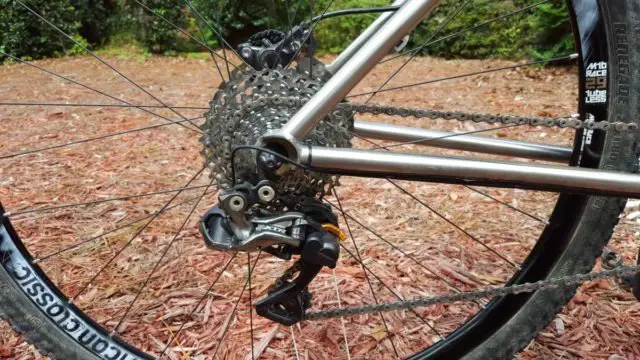
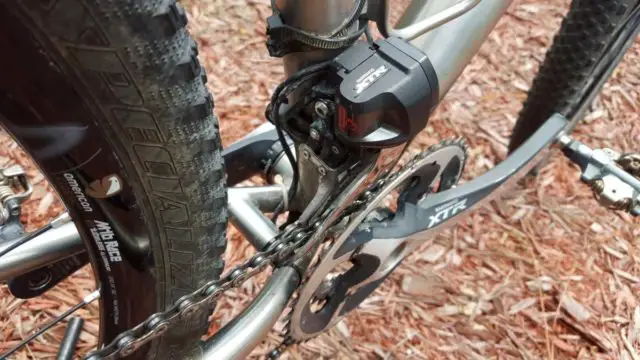


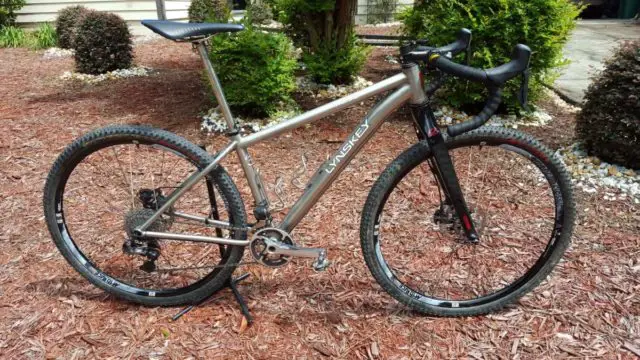
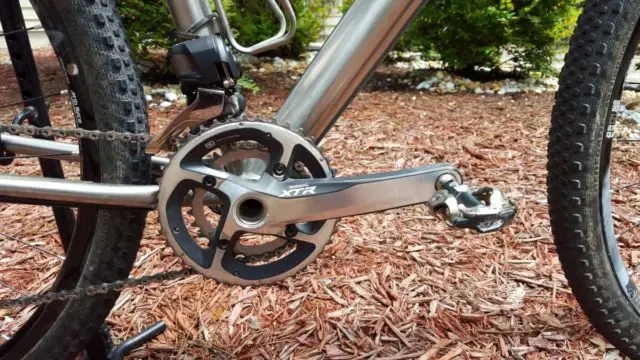
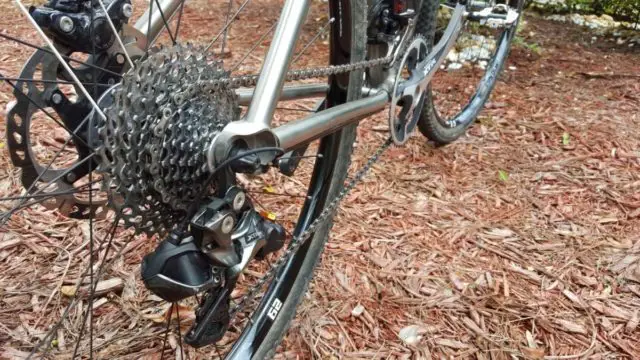
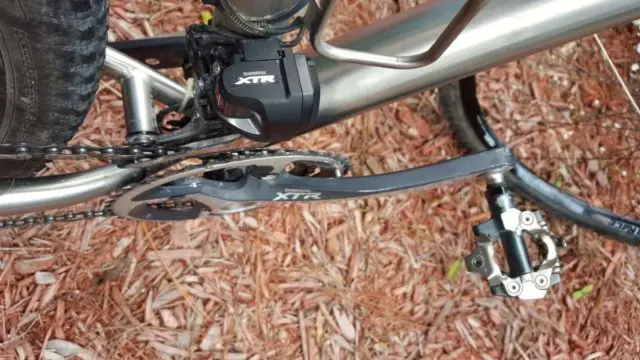
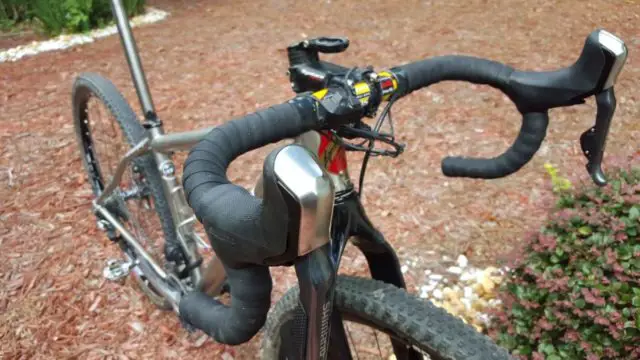
Hi Mr. JOM — How did you figure out your fit position when deciding to get this bike? For example, how did you fit/measure that drop bars on this frame would be a comfortable riding position on this mtn bike frame and have good handling?
Thanks,
Eric
Hey Eric,
I knew top tube length on the bike would be an issue, but Syntace makes some nice short and low stem options. I purchased two, and figured out the best fit. By no means is this the perfect rig, but it handles very well, and is extremely comfortable on long rides. Basically, I took a leap of faith hoping this would work out. My friend Dr. Pain went full custom with a similar rig – look here – https://www.gravelcyclist.com/bicycle-tech/dr-pains-monster-cross-bike/ – the build photos are out of date, as he too has changed many parts. At some point in the future, I would like to have a custom frame.
It appears your di2 wiring is external but your battery is internal (inside seatpost). How do you route the wire for the battery?
Hi James,
You are the only person to notice this. In a perfect world, my Ti frame would be drilled for Di2, but it was released before XTR Di2 existed. Unfortunately, there is insufficient room to mount the battery along the downtube below the front bottle cage. So, rather than drilling my own frame holes (which is extremely hard on drill bits with Ti), I improvised. The rear bottle cage is fixed to the frame using only the top bolt. The bottom of the cage is held to the frame by two stout zip ties.
With the lower bottle cage bolt hole now available, I routed the battery wire inside this hole, and connected to the seatpost battery. Not perfect, but it works. I have never had any issues with this configuration since I first built the bike almost two years ago. The cage has never come loose, or shifted any.
I have figured out an alternative wiring solution that would utilize the external battery mounted behind the seatpost, but not sure if I’ll go with that one yet.
What size frame is this? Did you convert using the same size frame that you would ride MTB on?
Size medium. Yes, used the same size frame I would ordinarily ride if running the bike configured as an MTB. Note the extra short stem I had to use to get close to my road position. Not ideal, but it works.
What’s final weight on this?
Weight is about 20.5lbs including pedals.
Thanks! That’s pretty good for a versatile setup.
JOM! I’ve done the same with an old Niner steel MCR9. To ensure the right fit, you must keep the same distances of your already fitted, for example, road bike. That usually means, when using a mtb frame that your stem will be probably shorter and in this case also with a pretty radical angle. The handling is different, but I have noticed that on very technical, low speed descents, the shorter stem is very helpful.
How’s the ride quality on the long rides?
Mike, I dialed in the position as close as possible to my road position. The Ti frame and Ti post really help with the overall comfort. I’ve knocked out several six to seven hour rides on the rig and can report ride quality is very good. The frame isn’t custom and not designed for drop bar riding, but it works remarkably well. Not as nimble as a true cross or gravel bike, it is very stable and performs very well on most road surfaces, particularly when the terrain gets really rough or the descending gets tricky. The bike has been a game changer for me on courses that I feel bikes with 40mm wide tyres are at a disadvantage – Iron Cross, etc.
Hi, is your front derailleur the di2 M9050 or M9070 model? Shimano website says the M9050 front derailleur is for a triple 3X system and the M9070 is for a double chainring 2X system? thanks
Bob, my front derailleur is the M9050 and is definitely for a double chainring system.
Would the XTR Di2 front derailleur work with a 44/30 crankset likely? I would like to run a 44/30 or 42/28 up front with an XTR 11/40 cassette in the rear. thanks
Bob, I personally use a 42/28 XTR 10-speed crankset with XTR Di2 and it works perfectly. You’ll have no problems with an 11-40 cassette.
JOM, have you tried that 11-40 cassette with Di2 yet?? I tried the SRAM XX1 rear derailleur and it would play nice with my 42 front ring
Wouldn’t!!
Mike,
I’ve run the 11-40 with XTR Di2 and Ultegra Di2 (but with a Lindarets Road Link). My Monster CX setup has a 42T front ring, you won’t have any troubles with XTR Di2… and XT Di2 is coming. However, I wouldn’t use the 42 x 40 combo… make sure your chain length is spot on. Play on the workstand before riding.
JOM
just looking at this now (due to https://www.gravelcyclist.com/race-reports/friday-flashback-three-peaks-usa-the-2012-edition/)
i dun care whachaya say: something’s not right when the seat-post is longer (or almost) than the seat-tube. otherwise: great review & bad-ass all the way! great review. thanks!
Actually working on a replacement for that bike… the Lynskey isn’t ideal, but it has helped me ride better and with more confidence in gnarly terrain!
JOM, thoughts on the 470mm RDO fork with this setup? I know the M290 frame is built for 100 to 120mm suspension forks, whereas the Niner fork is suspension corrected for 80mm. Have you noticed issues with handling or otherwise? Also, do you have a sense of how wide a set of tires you could fit into this frame/fork combo? Asking because: 1) I’m (very gradually) building up an M290 rig for singletrack riding, bikepacking/endurance races and ultra CX events, and would like to have the option of running tires in the 29 x 2.6 – 3.0″ range; and 2) Because Jenson has a pretty sweet deal on the Niner fork right now and I’m wondering whether to throw down or hold off for a 480/490mm carbon fork with 100mm suspension correction and 29+ tires (e.g., the Whisky No. 9 fork or the Salsa Cutthroat). Thanks!
Hi JOM,
Thank you for posting this useful information.
After an accident several years ago I got a permanent pain in the lower back. Currently, I ride a Bickerton foldable bike but I am thinking in building a custom bike as the one you build. Since, I cannot get Lynskey frames in Colombia, I would like to know if you evaluated other brands before building your custom bike.
Thanks.
Hello Ivan,
When I built this bike, I had my mind set on titanium and Lynksey made a superb deal at the time which I could not pass up. Have you checked with Lynskey themselves about shipping to Columbia? It cannot hurt to ask them – they have a chat function on their website where you directly connect with a customer service agent.
Good luck!
Jom, Do you think going one size smaller on the frame than what you would typically ride as a mountain bike would help with the top tube being too long?